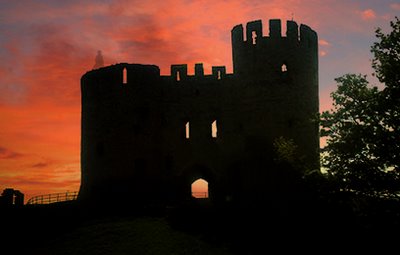
I was ten years old when it happened. Looking back I am sure it was her ghost that I saw that autumn evening from my bedroom window.
The town of Dudley, West Midlands is steeped in history. Its Norman Castle stands out from the highest point of this time honoured Black Country town like an old decaying tooth.
Although reputedly the home to more than one ghost, the wraith of the Grey Lady has returned through the centuries and haunted us mortals who care to link the past with the present, and who dare to be foolish enough to seek out the unknown.
As a child my home overlooked Dudley Castle, a mile distant to the west. One evening, I have no idea exactly how long ago, but it would have been in the mid sixties when I was a little boy, I was in my room, grounded by a throat infection. My bedroom window directly overlooked the Castle ruins. On this occasion, probably through boredom, I spent some time gazing out through the window as the sun went down behind the Castle. I could see, quite clearly, up there, on the battlements a human figure. The Castle grounds, which are also home to Dudley zoo, were closed for the day.
Being so far away, I could not make out whether it was a man or woman, but this very upright, slender figure slowly moved around the keep in a soft and un-deliberate flowing motion, sometimes pausing for a while before moving on.
After about ten minutes or so, and for no apparent reason it was no longer visible. By that, I mean that it was there one second, quite clearly, and then, nothing at all. I can recall the whole episode as if it was yesterday, and I remember still vividly that I was left with a sort of feeling of despair or ‘what’s the point’ as the experience unfolded before me.
The event puzzled me at the time, but I soon forgot all about it, until quite a few years later, when my mother mentioned that she had seen from the kitchen window, a shadowy figure that moved slowly around the Castle keep with a steady flowing motion and wondered if was the ghost of the Grey Lady.
My appetite for more knowledge on the Grey Lady and the haunted castle on my doorstep was honed.
During the English civil war, Dudley Castle was laid siege on two separate occasions. The second assault on the Castle took place in 1646, by a force of Parliamentarian troops led by General Sir William Brereton. The siege lasted for three weeks, and during this time, one Dorothy Beaumont, wife of the Garrison’s Second in Command, died within the Castle walls probably of natural causes connected with childbirth.
This left quite a predicament for the Royalist Commander Colonel Leveson. As there was no means of burial inside the Castle grounds, Mistress Beaumont’s body would have to be ‘committed to the ground’ in the usual way, by burial in the local churchyard, obviously before too much decomposition and the acompanying unpleasantness of putrefaction set in.
The problem was that the church nearest to Dudley Castle, St Edmunds, known locally today as ‘Lower Church’, had been pulled down by the Royalists as it was considered too close to the Castle and a possible place of concealment for the opposing Roundheads.
This meant the funeral would have to be held at St Thomas’s Church or ‘Top Church’, at the other end of what is now Dudley High Street and Market Place, and the other side of enemy lines.
Negotiations were hastily put in place and a brief ceasefire was observed as the funeral party, minus Dorothy’s husband passed through the Parliamentarians lines for a speedy burial in St Thomass churchyard.
Today, a fundraising event macabrely known as ‘The Coffin Race’, where two teams carrying coffins compete in a race from the Castle to St Thomas’s church, is held annually to raise cash for local charities.
The ghost of the Grey Lady still makes occasional appearances around Dudley Castle, often to the surprise of visitors. According to Staff at the Castle, on one occasion a group of visitors were being treated to a ghost talk. When an actress playing the part of the Grey Lady, dressed in period costume, joined the proceedings from the darkened end of the room, the audience became confused after seeing a second female figure also dressed in Grey waiting in the shadows near where the actress had made her entrance.
Organized Ghost Walks around Dudley which include the Castle grounds, the ruins of Dudley’s haunted Priory, and parts of the Town centre can be booked by visiting the Dudley Ghost Walk website. Keep watching The Hidden realm of Britain, I will be covering the Ghost walk in a future posting. JCA







